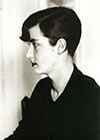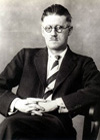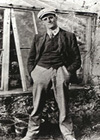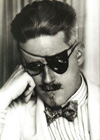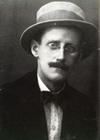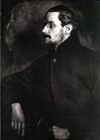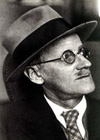
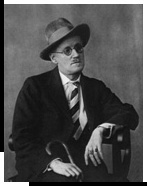
JAMES JOYCE
1882 - 1941
Photograph by Berenice Abbott
(1929)
“And whowasit
youwasit propped
the pot in the yard
and whatinthe
nameofsen lukeareyou
rubbinthe sideofthe
flureofthe lobbywith
Shite! will you
have a plateful?
Tak.”
— FINNEGANS WAKE
James Joyce's WORKS (Chronological)
Stephen Hero—Written 1901-04
Called by many "Stephen Dedalus-In the Rough," this incomplete novel written by James Joyce between 1901 and 1904 represents a "draft" version of his later novel, A Portrait of the Artist as a Young Man. The remaining manuscript serves as a collection of ideas and helps establish what Joyce means by the term "epiphany." The book's original manuscript was destroyed and only fragments of the work were collected, edited and first published in 1944-45 after Joyce's death. The incomplete manuscript presents much light on Joyce's development as an artist, filling in lacunae of thought and experience that became more obscure in his later work. Stephen Hero also provides a host of invaluable laboratory material for anyone interested in the technique of novel development.
To review a PDF commentary of Stephen Hero—CLICK HERE.
Chamber Music—1907
Chamber Music is a collection of poems by James Joyce, first published in 1907. The collection originally comprised thirty-four love poems, but two further poems were added before publication
To review a PDF copy of Chamber Music—CLICK HERE.
For Project Gutenberg's Edition of Chamber Music —CLICK HERE.
Dubliners—1914
Dubliners is a collection of short stories first published in 1914. These fifteen stories depict a naturalistic image of Irish middle class life in and around Dublin in the early years of the 20th Century. The stories in Dubliners were written when Irish nationalism was at its peak, and a search for a national identity and purpose was raging. Ireland was being jolted by converging ideas and influences and sat at a crossroads of history and culture.
The stories center on James Joyce's idea of an epiphany: a moment where a character experiences self-understanding or illumination. Many of the characters in Dubliners later appear in minor roles in Joyce's later novel Ulysses. The early stories in the collection are narrated by child protagonists, and as the stories continue, they focus on the lives, concerns and thoughts of progressively older people. In the structure of the book Joyce's tripartite division of the collection into childhood, adolescence, and maturity is represented by this progression of time.
To review a PDF copy of Dubliners—CLICK HERE.
For Project Gutenberg's Edition of Dubliners —CLICK HERE.
A Portrait of the Artist as a Young Man—1916
A Portrait of the Artist as a Young Man unleashed the power of James Joyce’s innovation and unconventionality upon the literary world. Semi-autobiographical in composition, Joyce's first published novel traces the intellectual and religio-philosophical awakening of the main character, Stephen Dedalus, as he begins to question and rebel against an upbringing of Catholic and Irish convention.
The book is an early example of Joyce's modernist writing techniques that would later be represented in much more developed forms in his later novels, Ulysses and Finnegans Wake. Notably, this novel makes use of some of the techniques that would make Joyce both famous and infamous in Ulysses, such as, stream-of-consciousness narration, interior monologue-dialogue, and frank realism that shocked some readers at the time of its publication.
A Portrait of the Artist as a Young Man is Joyce’s re-working of the classic "coming-of-age" story (the German term is Bildungsroman). A Portrait mirrors Joyce’s life up to the age of 20, when he left Dublin for Paris. Its challenging attitude with youthful directness and honesty with regard to family, homeland (Ireland), and the Catholic Church all gave the novel (and Joyce himself) quite the reputation when it was published.
To review a PDF copy of Portrait of the Artist as a Young Man—
CLICK HERE.
For Project Gutenberg's A Portrait of the Artist as a Young Man —CLICK HERE.
Exiles—Written 1915, Published 1918
Exiles is James Joyce's only play. It was rejected by theatres and scorned by most critics, but it reveals a valuable insight into his turbulent marriage and relationshiop with Nora Barnacle. Completed in 1915, the play bears the influence of Ibsen in theme and structure. Joyce said that it was not a play about adultery, rather it is a play about exile. The plot story involves two men, Richard and Robert, who were boyhood friends, meeting after an interval of nine years. They continue to feud for the affections of the same woman.
To review a PDF copy of Exiles— CLICK HERE.
Pomes Penyeach—1927
Pomes Penyeach is a collection of thirteen short poems by James Joyce. The collection was written over the period from 1904-24 and originally published 1927 for the price of one shilling (or twelve pennies) or twelve francs. The title of the work is a play on "poems" and “pommes” (the French word for apples). It was the custom for Irish tradespeople of the time to offer their customers a “tilly” (in Irish, tuilleadh) or an extra serving in the tradition of the “Baker's dozen” in England, offering thirteen loaves instead of twelve. This small collection is noted for a number of Joycean neologisms (such as, “rosefrail”, “moongrey” and “sindark”) which are created by melding two words into a new compound word. Joyce would use this technique extensively in Finnegans Wake.
To review a PDF copy of Pomes Penyeach— CLICK HERE.
Ulysses—1918-20, 1922
One of the most important books of 20th Century Modernist literature, Ulysses has been called a demonstration and summation of the entire modernist movement. Joyce worked to rework the process of thinking. The book stands as an inventive, multiple-point-of-view vision of daily events, personal attitudes, cultural and political sentiments, and observations of the human condition.
Ulysses is written in a number of differing literary styles, ranging from internal monologue to first-person speculation to question-and-answer from a catechism to newspaper headlines. The work has eighteen chapters and eighteen corresponding viewpoints. When taken in context with Joyce's grander design for it (a playful comparison to Homer's epic poem, The Odyssey), this novel gains complexity, irony, and dramatic intensity. Not only does the main protagonist, Stephen Dedalus, become all the more vivid because of his comparison to Telemachus—the son of Ulysses, King of Ithaca—in the Homeric epic, the other main character, Leopold Bloom, may be seen as the wandering Ulysses himself. In The Odyssey, Ulysses is seen returning to his wife, that symbol of womanly and cultural virtue, Penelope; whereas, in Joyce's novel, irony is used to represent Penelope as Molly Bloom, who that same afternoon was having an adulterous encounter with her lover, Blazes Boylan.
To review a PDF copy of Ulysses—CLICK HERE.
For Project Gutenberg's Edition of Ulysses —CLICK HERE.
Finnegans Wake—1939
Finnegans Wake is story with no real beginning or end (for example, it ends in the middle of a sentence and begins in the middle of the same sentence). This "book of Doublends Jined," as Joyce himself referred to it, is as remarkable for its use of prose as for its intricate circular structure.
The book is written as a fantantic dream language, created and forged from polyglot puns and portmanteau words, Finnegans Wake features some of Joyce's most brilliant and inventive writing. Sixty years after its original publication, it remains, in Anthony Burgess's words, "a great comic vision, one of the few books of the world that can make us laugh aloud on nearly every page." Considered to be Joyce's masterwork, the book is a dense collection of every stylistic method that the author employed in his literature and has been considered by many as one of the most difficult works of fiction in the English language.
To review a PDF copy of Finnegans Wake—CLICK HERE.
Back to Top of Page